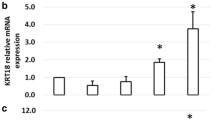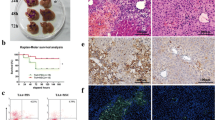Abstract
Liver dysfunction is a major health problem worldwide. Stem cells therapy has opened up new avenues for researches to treat liver diseases due to their multi lineage differentiation. As mesenchymal stem cells (MSCs) can be differentiated into hepatic lineages in the presence of different exogenous factors, the current study aimed to investigate the impact of carbon tetrachloride (CCl4) induced liver injured mice serum on MSCs differentiation toward hepatocytes in vitro. Male Balb/c mice were treated for liver injury with CCl4 as determined through biochemical tests spectrophotometrically and different growth factors (EGF, HGF) quantification through Sandwich ELISA in both normal and CCl4-induced liver injured mice serum. Mice bone marrow derived-MSCs at second passage were treated with normal and CCl4-induced liver injured mice serum. After 7 days, serum treated MSCs were investigated for hepatocytes like characteristics through RT-PCR. Serum biochemical tests (Bilirubin, ALT and ALP) and sandwich ELISA results of EGF and HGF showed marked increase in CCl4 treated mice serum as compared to normal mice serum. Periodic acid Schiff’s staining and urea assay kit confirmed high level of glycogen storage and urea production in cells treated with CCl4-induced liver injured mice serum. RT-PCR results of CCl4-induced liver injured mice serum treated cells also showed expression of hepatic markers (Albumin, Cyto-8, Cyto-18, and Cyto-19). This study confirmed that CCl4-induced liver injured serum treatment can differentiate MSCs into hepatocyte-like cells in vitro.



Similar content being viewed by others
References
Afshari A, Shamdani S, Uzan G, Naserian S, Azarpira N (2020) Different approaches for transformation of mesenchymal stem cells into hepatocyte-like cells. Stem Cell Res Ther. https://doi.org/10.1186/s13287-020-1555-8
Aggarwal S, Pittenger MF (2005) Human mesenchymal stem cells modulate allogeneic immune cell responses. Blood 105(4):1815–1822
Bae SH (2008) Clinical application of stem cells in liver diseases. Korean J Hematol 14(3):309–317
Baig MT, Ali G, Awan SJ et al (2017) Serum from CCl4-induced acute rat injury model induces differentiation of ADSCs towards hepatic cells and reduces liver fibrosis. Growth factors. https://doi.org/10.1080/08977194.2017.1392945
Chou SH, Kuo TK, Liu M, Lee OK (2006) In utero transplantation of human bone marrow-derived multipotent mesenchymal stem cells in mice. J Orthop Res 24(3):301–312
Dalakas E, Newsome PN, Harrison DJ, Plevris JN (2005) Hematopoietic stem cell trafficking in liver injury. FASEB J 19(10):1225–1231
English K, Ryan J, Tobin L, Murphy M, Barry F, Mahon BP (2009) Cell contact, prostaglandin E2 and transforming growth factor beta 1 play non-redundant roles in human mesenchymal stem cell induction of CD4 + CD25 Highforkhead box P3+ regulatory T cells. Clin Exp Immunol 156(1):149–160
Fausto N, Campbell JS (2003) The role of hepatocytes and oval cells in liver regeneration and repopulation. Mech Dev 120(1):117–130
Kakinuma S, Nakauchi H, Watanabe M (2009) Hepatic stem/progenitor cells and stem-cell transplantation for the treatment of liver disease. J Gastroenterol 44(3):167–172
Kang L-I, Mars WM, Michalopoulos GK (2012) Signals and cells involved in regulating liver regeneration. Cells 1(4):1261–1292
Lange C, Bassler P, Lioznov MV, Bruns H, Kluth D, Zander AR, Fiegel HC (2005) Liver-specific gene expression in mesenchymal stem cells is induced by liver cells. World J Gastroenterol 11(29):4497
Lázaro CA, Croager EJ, Mitchell C, Campbell JS, Yu C, Foraker J, Rhim JA, Yeoh GC, Fausto N (2003) Establishment, characterization, and long-term maintenance of cultures of human fetal hepatocytes. Hepatology 38(5):1095–1106
Lee DS, Gil WH, Lee HH, Lee KW, Lee SK, Kim SJ, Choi SH, Heo JS, Hyon WS, Kim GS, Paik SW (2004) Factors affecting graft survival after living donor liver transplantation. Transplant Proc 36(8):2255–2256
Ma X, Duan Y, Jung CJ, Wu J, VandeVoort CA, Zern MA (2008) The differentiation of hepatocyte-like cells from monkey embryonic stem cells. Cloning Stem Cells 10(4):485–494
Min J, Shang CZ, Chen YJ, Zhang L, Liu L, Deng XG, Yang M, Chen DP, Cao J, Song EW, Chen JS (2007) Selective enrichment of hepatocytes from mouse embryonic stem cells with a culture system containing cholestatic serum 1. Acta Pharmacol Sin 28(12):1931–1937
Nasir GA, Mohsin S, Khan M, Shams S, Ali G, Khan SN, Riazuddin S (2013) Mesenchymal stem cells and Interleukin-6 attenuate liver fibrosis in mice. J Transl Med 11(1):78
Schwartz RE, Reyes M, Koodie L, Jiang Y, Blackstad M, Lund T, Lenvik T, Johnson S, Hu WS, Verfaillie CM (2002) Multipotent adult progenitor cells from bone marrow differentiate into functional hepatocyte-like cells. J Clin Investig 109(10):1291–1302
Shams S, Mohsin S, Nasir GA, Khan M, Khan SN (2015) Mesenchymal stem cells pretreated with HGF and FGF4 can reduce liver fibrosis in mice. Stem Cells Int 2015:1–12
Takiguchi M (1998) The C/EBP family of transcription factors in the liver and other organs. Int J Exp Pathol 79(6):369–391
Waclawczyk S, Buchheiser A, Flögel U, Radke TF, Kögler G (2010) In vitro differentiation of unrestricted somatic stem cells into functional hepatic-like cells displaying a hepatocyte-like glucose metabolism. J Cell Physiol 225(2):545–554
Wankhade UD, Shen M, Kolhe R, Fulzele S (2016) Advances in adipose-derived stem cells isolation, characterization, and application in regenerative tissue engineering. Stem Cells Int 2016:1–9
Wright NA, Alison M (1984) The biology of epithelial cell populations. Oxford University Press, USA
Acknowledgements
The authors would like to thank Abdul Wali Khan University Mardan, Pakistan for providing financial support and research facilities for this research work.
Funding
No funding received for the current study.
Author information
Authors and Affiliations
Corresponding author
Ethics declarations
Conflicts of interest
The authors declare that they have no conflicts of interest.
Ethical approval
All the manipulations with animals were carried out in accordance to the informed consent protocol approved by the Ethics Committee of the Abdul Wali Khan University Mardan. This article does not contain any studies with human participants performed by any of the authors.
Additional information
Publisher's Note
Springer Nature remains neutral with regard to jurisdictional claims in published maps and institutional affiliations.
Rights and permissions
About this article
Cite this article
Shams, S., Imran, N., Afridi, S.G. et al. In vitro differentiation effect of CCL4-induced liver injured mice serum on bone marrow-derived mesenchymal stem cells toward hepatocytes like cells. Cell Tissue Bank 22, 297–303 (2021). https://doi.org/10.1007/s10561-020-09878-5
Received:
Accepted:
Published:
Issue Date:
DOI: https://doi.org/10.1007/s10561-020-09878-5




